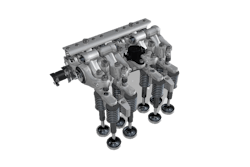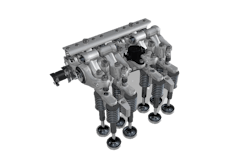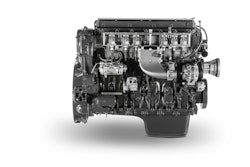Jacobs Vehicle Systems, the world’s leading manufacturer of heavy-duty diesel engine retarding systems and valve actuation mechanisms, will further emphasize its High Power Density (HPD) Engine Brake technology at the 66th IAA Commercial Vehicles (September 22-29, 2016; Hannover, Germany). A demo truck equipped with the HPD Engine Brake has been touring test tracks, and vehicle and engine OEM facilities across Europe since April and will take center stage on the Jacobs stand B34 in Hall 16.
The production-ready Jacobs HPD Engine Brake realizes one-and-a-half times the braking performance of traditional compression release braking over the engine’s entire operating range and more than two times the braking performance at lower rpm (the same retardation at 1,400 rpm as at 2,100 rpm previously). Jacobs’ new calibration and revised cam design delivers 2,000 Nm of retarding torque at 1,300 rpm and beyond, and 611 kW power at 2,500 rpm in a 13-L engine, compared to 416 kW at 2,100 rpm on the standard, identical engine. This provides large engine displacement retarding power in small and medium displacement diesel and natural gas engines. While delivering revolutionary braking performance, the HPD system is quiet in operation (it had notably lower peak positive power noise than the four-stroke engine braking in NVH drive-by tests), being fully integrated into the customer engine’s overhead design. It can also assist with exhaust aftertreatment thermal management by preventing the catalyst from cooling during descents.
Sergio Sgarbi, Jacobs Vehicle Systems President, says, “Jacobs invented the High Power Density Engine Brake five years ago, bringing the technology to the point where this year, we became ready to invite customers to drive it for the first time in a modified demo truck. At IAA, we would like to invite more potential customers who have heard about HPD in the media and from industry colleagues to come to our booth and learn more about the technology. We see a perfect opportunity for the HPD brake in Europe, where there is a premium on retarding power and where Jacobs’ conventional compression release engine braking has been adopted by Daimler, Renault, DAF, Deutz and Volvo.”
Setting a new world record
On April 11, 2016, Jacobs Vehicle Systems surpassed its previous engine brake retarding world record with the new HPD Engine Brake. At its state-of-the-art engineering laboratory in Connecticut, Jacobs achieved 819 retarding horsepower (611 kW) utilizing a 12.8 L engine operating at 2,500 rpm engine speed. This sustained power level was reached within the acceptable limits for engine durability and safety using a 900 hp AC motoring dynamometer. This set a new power level and power density record 63.98 hp/L (47.7 kW/L).
Why HPD?
Jacobs’ HPD Engine Brake was developed in response to the drive by global engine suppliers to provide higher levels of engine braking performance at lower engine speeds and improve thermal management to match industry trends such as downspeeding and downsizing of engines, which are driven by the need for better fuel economy and lower total cost of ownership. Engine brake retarding performance is becoming increasingly important because key strategies for improving fuel efficiency are reducing the natural retarding of the vehicle caused by wind resistance, engine, drivetrain, and rolling resistance from the tires.
Jacobs’ HPD Engine Brake transforms the four stroke engine into a two stroke compression device by deactivating the main intake and exhaust valve events and supplementing with two stroke valve events. Whereas a conventional engine brake has one compression release and one brake gas recirculation event per cam rotation, this innovative and patented two-stroke technology achieves two braking events per cam rotation. It is fully variable with controlled boost modulation, which allows the driver to achieve the right balance between retardation, speed and efficiency.
Because Jacobs’ HPD Engine Brake uses standard, proven technology components, it also offers a cost advantage. At a fraction of the price of hydraulic retarder devices it delivers an average return on investment of six months compared to an average of two-and-a-half years for hydraulic retarder devices.

















